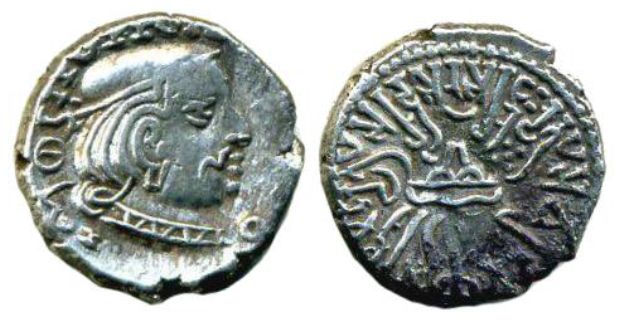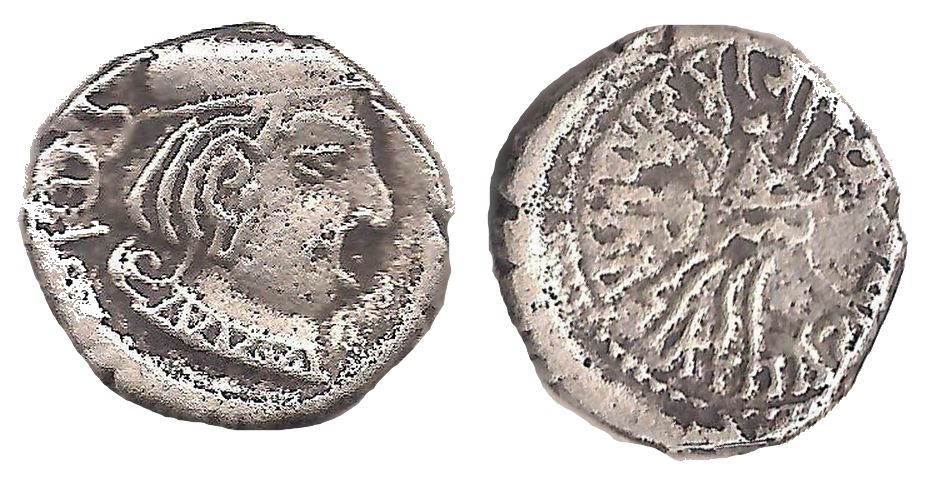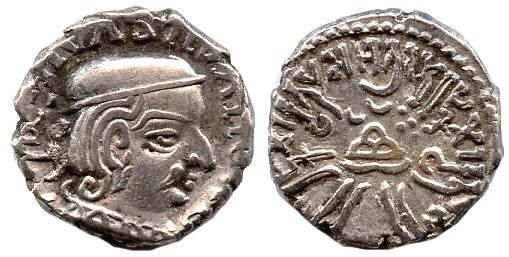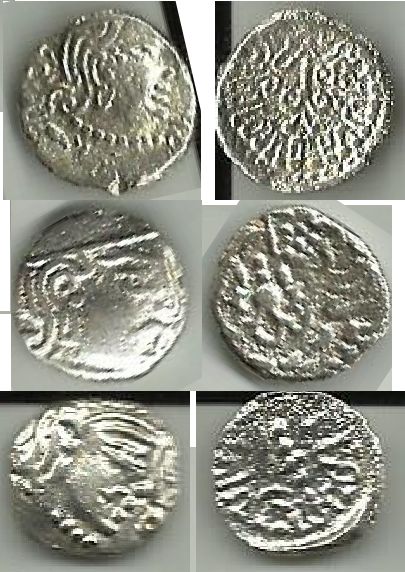|
|
Resources for collectors:
Fall 2013 - reports of the first known fake silver coins of the Western Kshatrapas
If you want to use some of this page or some of the images - please ask first. Please do not copy the information shown here and reproduce it elsewhere.
Last update: November 2014
(Very short) history of the Kshatrapas
Early History of the Kshatrapas and their coinage:
The information below is taken from my 2 books on the coinage of the Kshatrapas - I published these two books earlier in 2013. They are full of information and photographs of the coins of the Western Kshatrapas, including many types and rulers never before published. If you are interested in this coinage, please check the books, they should be useful to any collector of ancient Indian coins.
|
|
The “Western Kṣatrapas” (more commonly known in the West as the “Western
Satraps”) is a collective name for the rulers from a number of different
families ruling in Gujarat, Saurashtra and Malwa in the 1st-5th century AD. This
catalogue is concerned with the lead, copper, bronze, potin and billon coins of
two of these dynasties, the Kshaharātas and the Kārdamakas.
The Western Satraps were Scythian (Śaka) rulers of the western and
central parts of India (parts of Saurashtra and Malwa: modern Gujarat, Southern
Sindh, Maharashtra, Rajasthan and Madhya Pradesh states). Their state was called
"Ariaca" according to ancient Greek Periplus of the Erythraean Sea, with the word “Ariaca” probably
derived from the reference to the “Arian” (that is, Scythian) origins of the
Indo-Śakas. These “Arians” were the successors to the Indo-Scythians, though
their exact relationship to the earlier Indo-Scythians and Indo-Greek rulers of
Northern and Western India is not known. They were also contemporaneous with the
Kushans who ruled a vast empire spanning northern part of the Indian
subcontinent and huge tracts of land in Central Asia. The early Kṣatrapas
were also the neighbors of the powerful Indian Empire of the Satavahanas
(Andhras), which governed Central India and acted for many generations as the
arch nemesis of the Kṣatrapas,
despite being related to them by close family ties. Throughout the long history
of the Western Kṣatrapa Kingdom, many other kingdoms rose and fell on the borders of their
domains – the Kushans, the Vakatakas, the Taikutakas and the powerful Guptas,
who finally conquered and annexed the Western Kṣatrapa
Kingdom.
The extent of the Western Satraps’ Kingdom at the high of its power under
Rudradāman is known from various inscriptions. However, our knowledge about the
later (and earlier) boundaries of the Kingdom is derived from indirect
information about the conflicts, invasions and establishments of other powers in
the territories formerly belonging to the Western Satraps. The power of the
Western Satraps shrunk considerably over the centuries, and by the 4th
century AD their Kingdom was probably confined to Kathiawar and perhaps small
parts of Malwa.
Most of the
Western Kṣatrapas issued beautiful silver coins in a single
denomination – the dynasty is now known mainly because of this silver coinage.
These coins, usually measuring 13-15mm in diameter and weighing around 2-2.1
grams, are commonly referred to as “drachms”.
The early
coins of the rulers Chaṣṭana,
Jayadāman, Rudradāman, Viśvasiṁha
I and the early coins of Dāmajadaśri and Rudrasiṁha
I are undated, but almost all later coins carry dates in Śaka Era years. This
practically uninterrupted series of remarkable dated coins lasted for well over
200 years, from 99 SE (177 AD) to 337 SE (415 AD), and the entire dynasty of the
Western Kṣatrapa rulers can be reconstructed with a precision that is unprecedented among
any other ancient India royal dynasties. In addition to the silver coins, a
variety of potin, lead and copper coins were issued – these coins are the
subject of this book. They were never properly studied and catalogued, though
many pieces do appear in various older publications. Numerous new types and
varieties in a number of different metals are published in this book for the
first time
The fake coins:
The fake silver coins of the Western Kshatrapas are almost unheard of. The reverse has a long and a very complex inscription, and making these coins with fake modern dies would be very difficult. One such coin might be a coin of Prthivisena II from 146 SE, but I think even that coin is authentic.
Cast copies of the silver Kshatrapa coins were long expected, but I have not encountered any, even though I've been keeping a very close eye on the Kshatrapa coins on the market for many years now. The reason why these coins were left alone by the counterfeiters is because the coin are small (usually 14-15mm in diameter) and light (usually about 2.1 grams). They are also quite cheap (as far as ancient coins go) and it seems the counterfeiters did not bother faking them until now. The fake coins are sold out of India by a few previousely unknown sellers.
The fake coins of the Kshatrapas are now known in 6 different types (and more seem to appear regularly). The coins are all cast from real pieces, and seem to have been mass-produced, as numerous pieces are being sold on ebay as authentic. The same faker also made some Maitrakas and Gupta silver pieces using the same casting method.
Fake coin #7
This is a coin of Mahakshatrapa Rudrasena I
 |
|
 |
This is a fake coin of Rudrasena I. The reverse is very poorly cast and looks flat, blurry and pitted. |
Fake coin #6
This is a coin of Mahakshatrapa Rudrasena II
 |
Original coin is "The Silver Coinage of the Western Satraps in India (50-400 AD), Catalogue and Price Guide" (A.M.Fishman) #27.1.188 |
 |
This is a fake coin of Rudraseva II, showing the complete date 188 SE. These were among the earliest fake kshatrapas to appear. All are softly cast and seem to be pitted. |
Fake coin #1
This is a coin of Mahakshatrapa Bhartrdaman,
son of Rudrasena II
These are the coins of Bhartrdaman (unfortunately, better images were not available). All are crudely cast from the same original coin.
 |
Authentic coin of Bhartrdaman. Original coin is "The Silver Coinage of the Western Satraps in India (50-400 AD), Catalogue and Price Guide" (A.M.Fishman) #29.3 |
||||||||||||||
 |
Fake coin - Sold on ebay in September 2013 by an Indian dealer. The coin is softly cast, with the traces of the casting channel at 10 o'clock on obverse. The fake coin has two semi-circular countermarks on the obverse (a common feature for the real coins of this period). | ||||||||||||||
| Numerous coins made from the same cast were sold on ebay after September 2013 (I am not picturing them, since they all look very much alike). | |||||||||||||||
Fake coin #2
This is a coin of Mahakshatrapa Rudrasena III,
son of Rudradaman II
|
|||||||||||||||
|
Fake coin #3
This is a coin of Mahakshatrapa Rudrasimha III,
son of Satyasimha
Fake coin #4
This is a coin of Mahakshatrapa Rudrasimha III,
son of Satyasimha
In addition to the Kshatrapa coins described above, the same forger made at least 3 types of Gupta fakes, cast from the common Gupta silver coins. One Maitraka type fake is also known. All are cast using the same method as the Kshatrapas, and all show weakness/pitting. The three known fakes are shown below.  |
|||||||||||||||
Go back to the "resources for collectors" page
***
If you have any questions or comments, please email me @ alex@ancientcoins.ca
***